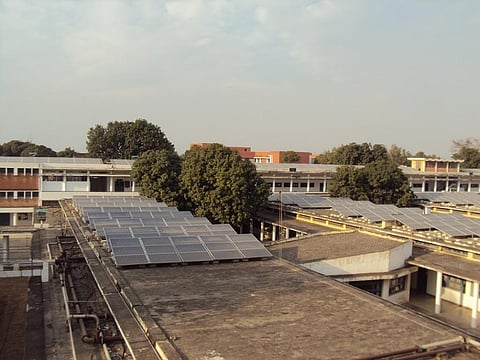Decentralised renewable energy solutions offer great promises for healthcare facilities
It has been a big challenge for our health infrastructure to deal with the novel coronavirus disease (COVID-19). It has also prompted a wider realisation that we need to strengthen our health institutions, not only for any future waves of pandemics, but even more for ensuring longer, healthier lives for our people.
In normal times, our health institutions face resource constraints, with electricity bills draining their limited resources.
Apprehension about a third wave of COVID-19 has many health institutions setting up their own oxygen plants within their premises. These oxygen plants consume approximately 5 kilowatt-hour per normal metre cube of oxygen. Excluding depreciation, the electricity cost would be 70-80 per cent of the running cost.
Health institutions in the country have a difficult time meeting their regular expenses even without these oxygen plants. Now, their burden would be even greater.
Many health institutions have attempted setting up oxygen plants within their premises under the PPP mode (design-build-finance-operate-transfer). But electricity costs make these projects unviable and unable to compete with the far larger liquid medical oxygen plants. This has driven away private investors.
In the post-pandemic world, energy access interventions involving rooftop photovoltaics (RTPV) can help health facilities become ‘atmanirbhar’ (self-reliant). It has been repeatedly emphasised that “decentralised renewable energy solutions offer a unique opportunity to provide clean, reliable and cost-effective electricity, which would significantly improve healthcare services in rural as well as urban communities”.
Business cases for RTPV interventions in large health facilities are driven by rising electricity costs and substantial drop in solar photovoltaic costs in recent years. Hospitals in almost every state are charged the highest rate, the one applicable for commercial customers. If we consider only the variable component of retail electricity tariff, grid electricity in most states is priced Rs 6-8 per kWh.
The RTPV system can produce significant savings for daytime electricity consumption. The state of Madhya Pradesh in mid-2018 discovered the electricity tariff for medical colleges under the RESCO model, a renewable energy service company: Re 1.74 / unit with three per cent annual escalation with subsidy support from the state and central governments.
The discovered rate would have been Rs 2.18 / unit (with three per cent annual escalation) without the subsidy, still a fraction of what medical colleges pay for grid-supplied electricity.
Electricity savings can be used to purchase medicines and for other necessary expenditures, as well as to strengthen the health infrastructure.
A 234-kW RTPV project has been commissioned at the Government Medical College, Shivpuri as part of the project. This has led to saving of more than Rs 15 lakh in the first year and expected cumulative savings over project life of around Rs 7 crore. This is with zero investment by the medical college.
Further, the project results in approximately 7,187 tonnes of carbon dioxide emissions being reduced over the project life. This environmental gain would have been achieved by planting 12,345 trees.
Even in rainy months, the project produces 60 per cent of the average amount of energy in other months. The RTPV electricity can also be used to provide basic lighting, fans, cold chain equipment for vaccine storage and oxygen concentrators for onsite use, as well as other critical medical and laboratory equipment for providing essential healthcare services during the day.
The high initial cost of RTPV intervention is one of the reasons state governments overlook such investments, given the budgetary constraints of making significant capital expenditures. NITI Aayog's and the World Bank's SuBaH initiative aims to bridge these gaps by demonstrating the OPEX / RESCO model to provide affordable RTPV electricity services to health facilities.
The health institutions or governments would therefore not have to make any investment whatsoever and would make savings from day one. The investment would be made by solar developers, who would recover their investment through the sale of power to the health institutions over the 25 years.
Efforts in demand aggregation planned under the initiative will optimise upfront costs and reduce the overall cost of energy services through economies of scale.
In a preliminary assessment published by the Union Ministry of Health and Family Welfare, the potential for RTPV in all district hospitals and medical colleges of our public healthcare system is estimated to be approximately 450 MW, entailing an investment of about Rs 1,575 crores and generating over 13,000 jobs locally.
In facilitating access to affordable RTPV electricity in public healthcare facilities, India can achieve the twin objective of greening the economy and transforming the healthcare infrastructure so that it can provide affordable health services.
In order to meet the energy access needs of healthcare facilities, the energy and health sectors, including the ministries of power and health, need to work together at all levels, including policies, budgets, procurement and implementation.
Cooperation between the private sector, the public sector and non-governmental organisations has proven crucial to the success of healthcare electrification, such as using the pay-as-you-go model in Rwanda, micro-grids anchored around the facilities and connected to staff housing in Madagascar and Lesotho. Such partnerships should be encouraged.


.jpeg)